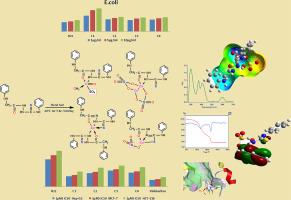Liver, breast and colon anticancer, DNA binding and antimigration investigation of mono- and binuclear metal complexes with theoretical studies
IF 3.3
Q2 MULTIDISCIPLINARY SCIENCES
引用次数: 0
Abstract
Four new complexes of [VO(H2L)(H2O)(SO4)]EtOH (C1), [Co(HL)(NO3)] (C2), [Zn(H2L)(HL)]Cl.H2O (C3), and [Zn2(H2L)(SO4)2]2H2O (C4) of [N-phenyl-2-(phenylglycyl)hydrazine-1-carbothioamide] (H2L) have been synthesized and characterized by various techniques. All metal complexes are mononuclear in nature except [Zn2(H2L)(SO4)2]2H2O (C4) complex is binuclear, and the chemical formulas of the complexes are (1:1 of C1 and C2), (1:2 of C3) and (2:1 of C4) (M:L). DFT calculation is performed and supports the expected structures. The compounds were tested against different types of positive and negative bacteria and also against three distinct human cancer cell lines: liver (HepG-2), breast (MCF-7) and colon (HCT-116). [VO(H2L)(H2O)SO4]EtOH (C1) is regarded as the most effective and potent antibacterial agent since the results indicated that it has the highest inhibition zone, even greater than that of the conventional antibiotic. Additionally, that vanadyl complex exhibited the highest anti-inflammatory effect and the greatest anticancer activity against the three tested cell lines. All compounds exhibited anticancer activity against the examined cell lines in the following order: C1 > C2 > C4 > C3 > H2L. The high affinity of the vanadyl complex to DNA interaction was confirmed through the electrophoresis technique. The wound healing test revealed that the HepG-2 cell migration was inhibited when treated with VO(II) complex. According to a molecular docking study, the ligand and complexes revealed fascinating interactions with amino acid residues in the binding site of the EGFR tyrosine kinase receptor (PDB Code: 1M17).

单核和双核金属配合物抗肝癌、乳腺癌和结肠癌、DNA结合和抗迁移的研究与理论研究
四个新复合物(VO (H2L) (H2O) (SO4)] EtOH (C1),[有限公司(HL)(三)](C2),(锌(H2L) (HL)] Cl。用各种方法合成了[n -苯基-2-(苯基酰)肼-1-碳硫酰胺](H2L)的H2O (C3)和[Zn2(H2L)(SO4)2]2H2O (C4)。除[Zn2(H2L)(SO4)2]2H2O (C4)配合物为双核外,其他金属配合物均为单核,其化学式为(C1和C2的1:1)、(C3的1:2)和(C4的2:1)(M:L)。执行了DFT计算,并支持预期的结构。测试了这些化合物对不同类型的阳性和阴性细菌的作用,以及对三种不同的人类癌细胞系的作用:肝癌(HepG-2)、乳腺癌(MCF-7)和结肠癌(HCT-116)。[VO(H2L)(H2O)SO4]EtOH (C1)被认为是最有效和最有效的抗菌剂,因为结果表明它具有最高的抑制区,甚至大于常规抗生素。此外,vanadyl复合物对三种被试细胞系表现出最高的抗炎作用和最大的抗癌活性。所有化合物对所检测的细胞系表现出抗癌活性,顺序如下:C1 >; C2 > C4 > C3 > H2L。通过电泳技术证实了钒基配合物对DNA相互作用的高亲和力。伤口愈合实验显示,VO(II)复合物能抑制HepG-2细胞的迁移。根据分子对接研究,配体和复合物揭示了与EGFR酪氨酸激酶受体(PDB代码:1M17)结合位点氨基酸残基的有趣相互作用。
本文章由计算机程序翻译,如有差异,请以英文原文为准。
求助全文
约1分钟内获得全文
求助全文
来源期刊

Scientific African
Multidisciplinary-Multidisciplinary
CiteScore
5.60
自引率
3.40%
发文量
332
审稿时长
10 weeks
 求助内容:
求助内容: 应助结果提醒方式:
应助结果提醒方式:


